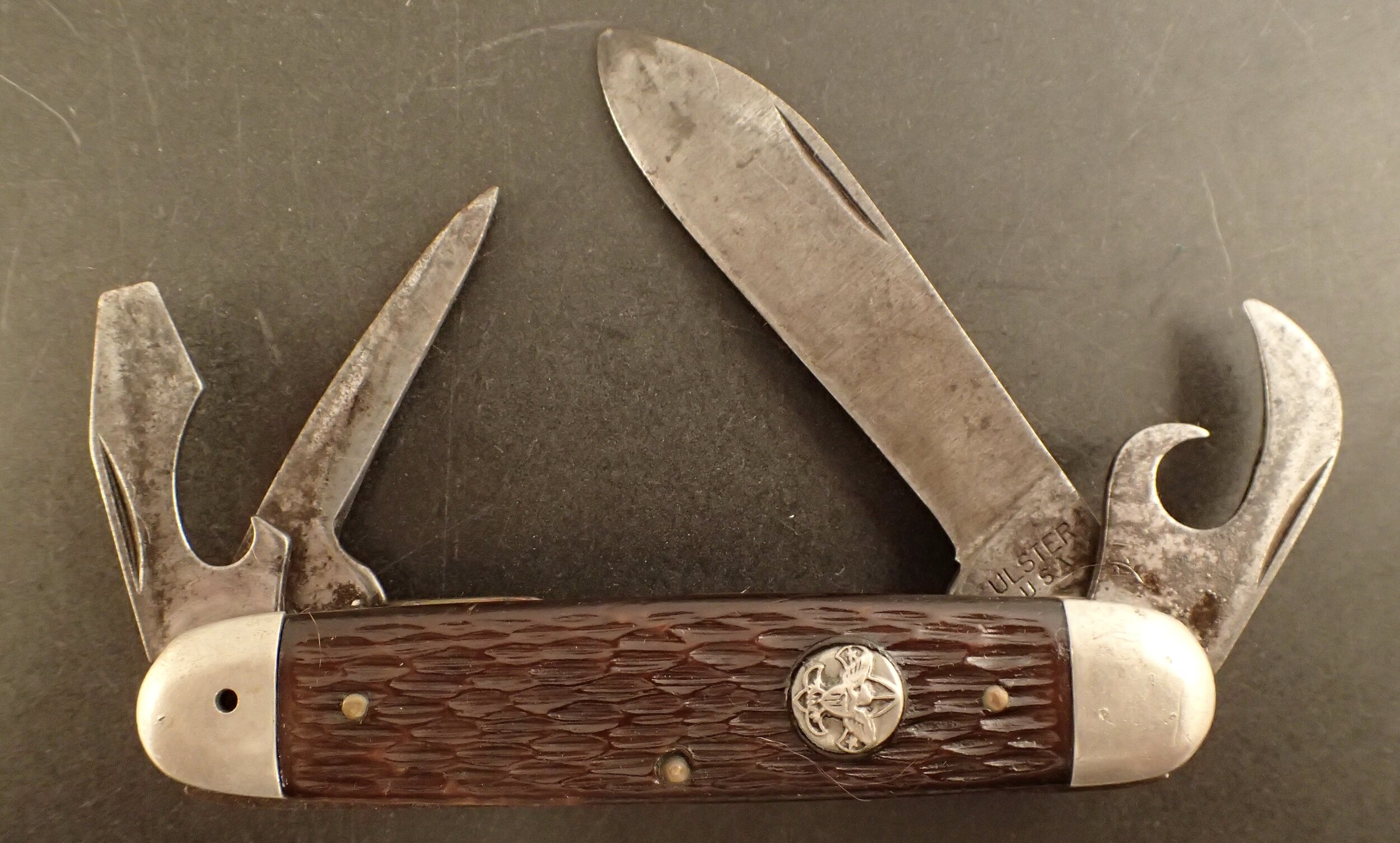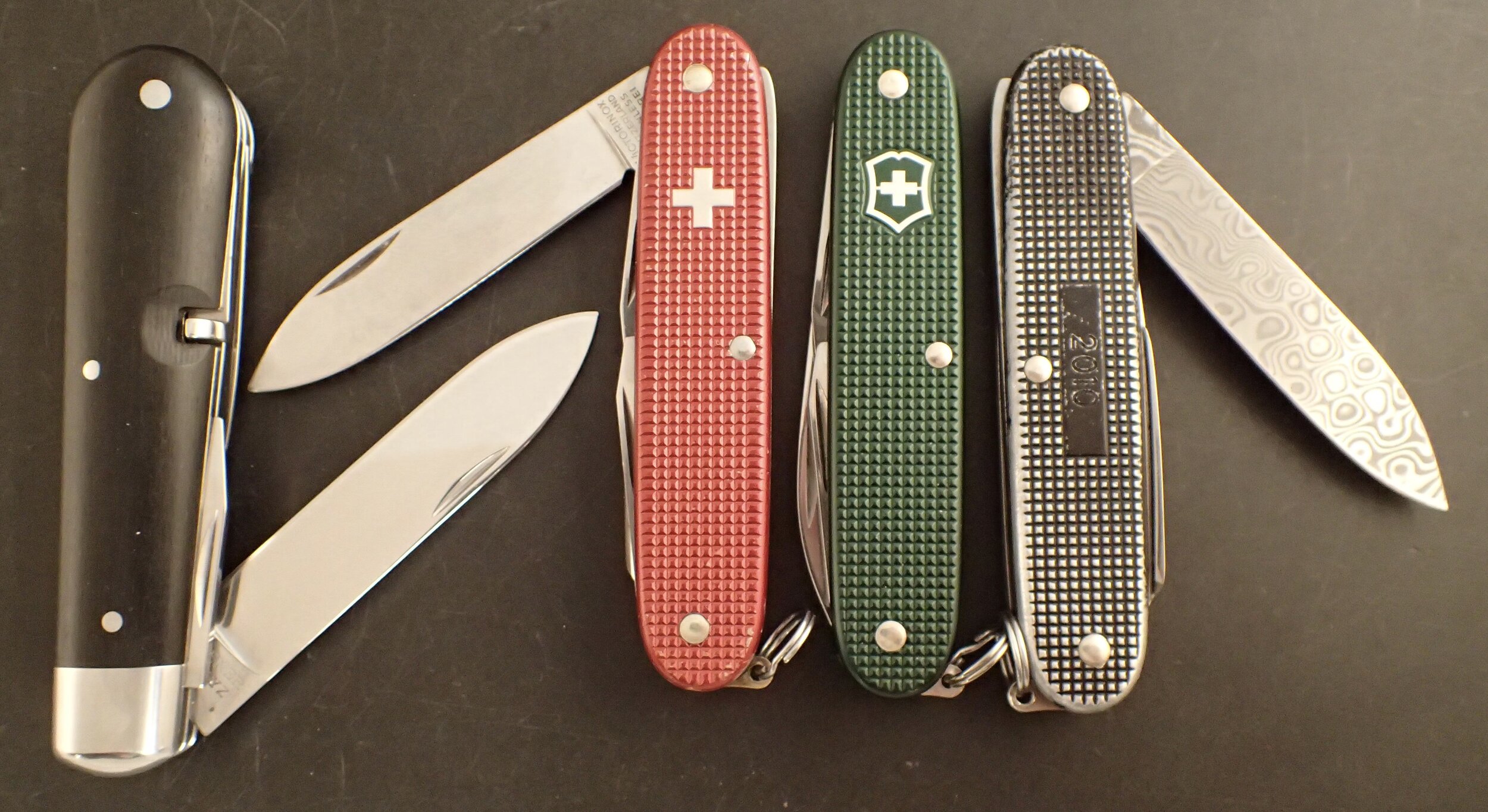Collecting the Model 1961 Soldier Knife, Part 3: Scout Pattern Knives.
Myron Erickson
Welcome to the third article in what started out as a series of two on the Victorinox Pioneer and Model 1961, my favorite and arguably the greatest pocket knife of all time. The Pioneer was introduced in 1957 and almost immediately served as the basis for the design of the Model 1961, the SAK that was standard issue to the Swiss military for 47 years, from 1962 to 2008.
A Pioneer and Model 1961, in this case a Wenger.
In Part 1 of the series I introduced the Pioneer and Model 1961, and in Part 2 of the series I described how the Model 1961 evolved across the decades in six main collectible versions. Some of the Model 1961’s cousin SAKs, like the Swiss Rail Black Beauty and the Dutch Army Knife, are discussed there as well. The idea I want to share with you in Part 3, dear reader, is that the Pioneer/Model 1961 is so brilliant not because it was a brand new game-changing idea when it came out, like the iPhone was when it was released in 2007. No. Rather, it is because the Pioneer is the most thoughtfully designed and beautifully executed instance of an earlier and already proven concept, the basic scout pattern folding knife.
Two BSA scout pattern knives, a Victorinox Pioneer (1990’s) and an Ulster (1970’s).
The scout pattern knife.
Think about the basic scout pattern folding knife and its four implements — knife blade, can opener, screwdriver/cap lifter, and the awl/reamer — and probably the first example that comes to mind is the Boy Scout knife itself. I knew the BSA was established in 1910 and that the Victorinox Model 1890 (which, like the Model 1961, was named for the year it was designed) had already been around for 20 years before that. But I couldn’t think of a scout/utility knife older than the Victorinox Model 1890, so I decided to look into it. Turns out the basic scout knife pattern is much older.
Scout knives have a way of being handed down. This Ulster is 50 years old and has been carried by two Eagle Scouts in my family.
In the now-classic Levine’s Guide to Knives, Bernard Levine describes four-blade utilitarian folding knives dating back at least to the 18th century that were produced by German, Bohemian, French, and Swiss makers. But Guru Levine also confirms that the standard four-blade scout/utility knives offered by American manufacturers began to appear around 1900: “The standard utility knife is 3-5/8 inches long closed, and has two back springs and a bail. It has four blades: ordinarily a spear master blade, a punch, a can opener, and a screwdriver/cap lifter. What brought the four-blade utility knife widespread popularity in the United States was its designation in 1910 or 1911 as an official style of pocketknife for the Boy Scouts of America.”
So there you have it. Although they both descend from 300-year old fore-knives, I think our modern, popular utilization of scout pattern knives really has the Boy Scouts to thank, and it’s difficult to think that the BSA Scout knife was not influenced by the earlier Model 1890, itself produced by a dozen Swiss and German makers.
The original design for the Victorinox Model 1890 Soldier Knife. Image compliments of SAKWiki.
The Victorinox Model 1890, revered ancestor of the Pioneer.
The Model 1890 SAK was so perfect when it entered use in 1891 that it soldiered on essentially unchanged for 70 years until it eventually evolved into the Model 1961, which enjoyed another 47-year career. A fuller discussion would have to include the intermediate models, the 1901, the 1908, and the Model 1951, but it is certainly correct to say the Pioneer/Model 1961 is the direct descendant of that original great-great-grandfather scout pattern knife, the Model 1890.
The Victorinox Soldier’s Knife 1891 LE from 2009.
I don’t own an actual Model 1890, and you’d have to be a more serious collector than I am to have one in your collection. They’re old, and like any vintage thing, they can have their share of vintage issues like genuineness, bodged repairs, and broken implements and springs. The only one I’ve seen recently on the big auction site had a buy-it-now of $1300 and didn’t even last 24 hours. Maybe someday, but for now I’m happy to have the re-issued Model 1890 that Victorinox produced in limited numbers to celebrate their 125th anniversary in 2009. I wrote a little more about this very special limited edition in my Summer Reflections article last year.
The Pioneer, the scout pattern knife perfected.
By the time the Pioneer was introduced to the civilian world in 1957 and in turn became the basis for the Model 1961 that entered military use only five years later, the implements had been tweaked to meet more modern needs, and they continue in these forms today. The can opener on that first Pioneer was a completely different design from those on its progenitor SAKs — top-operating instead of side-operating — and it also now functioned as a small Phillips head screwdriver.
The Model 1890 re-issue with three Pioneers from different decades.
And we were apparently drinking beer and soda out of bottles by 1957, so the redesigned flat blade screwdriver also served as a cap lifter for that bottle of brew rolling around in the bottom of your canoe or tucked into the side pocket of your rucksack. And when you think about it, doesn’t it seem strange that it took Victorinox 70 years to include a bottle opener on the soldier’s SAK, since crimped bottle-capping technology dates to the 1850’s and the so-called “officer’s” knives had already featured the cap lifter and the corkscrew for decades? The life of the Swiss soldier was a sober one, it would seem.
You’ve been paddling all day and someone produces a six-pack of Two Hearted Ale. Which tool are you going to be happier to have?
These small improvements and the tardy addition of the bottle opener notwithstanding, the basic functionality of the four-implement toolset remained the same across innumerable manufacturers for literally the entirety of the 20th century, and continues to this day. Camillus, Case, Bear, Remington, Schrade, Imperial, as well as numerous British, German, Swiss, and other American manufacturers all produced a scout pattern folding pocket knife. The design perfection of the basic scout pattern knife is the reason it is still with us today in the form of the Victorinox Pioneer and other worthy pocket knives. If you buy a Pioneer that was made in 2020, you’re essentially getting a contemporary Model 1961 soldier’s SAK, which itself is just the update of the original Model 1890. Great-great-grandknife would be so proud.
A pile of Pioneers and one Model 1961.
This concludes Part 3 of my 2-part series on the Victorinox Pioneer/Model 1961. Watch this space for Part 4, comparing the Model 1961 to the Camillus Model 1760, the American SAK. Also still to come is Part 5, my Big Year of completing the set of Model 1961 issue years. I’ll be sharing tips, hints, and the most common mistakes of collecting vintage Pioneers and Soldier SAKs, so you won’t want to miss it.
Thank you for reading my blog. I welcome your comments or factual corrections, and if you have a favorite scout pattern knife, please get in touch. I would love to know more about the history of this design, Boy Scout knives, and the Victorinox Model 1890.








